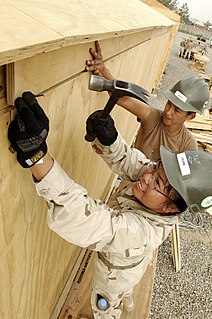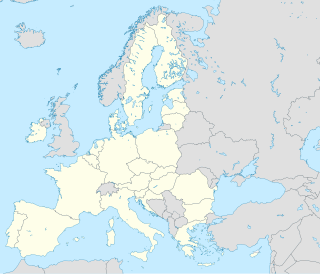A bloodborne disease is a disease that can be spread through contamination by blood and other body fluids. Bloodborne pathogens are microorganisms such as viruses or bacteria. The most common examples are HIV, hepatitis B (HVB), hepatitis C (HVC) and viral hemorrhagic fevers.

A work accident, workplace accident, occupational accident, or accident at work is a "discrete occurrence in the course of work" leading to physical or mental occupational injury. According to the International Labour Organization (ILO), more than 337 million accidents happen on the job each year, resulting, together with occupational diseases, in more than 2.3 million deaths annually.

The National Institute for Occupational Safety and Health is the United States federal agency responsible for conducting research and making recommendations for the prevention of work-related injury and illness. NIOSH is part of the Centers for Disease Control and Prevention (CDC) within the U.S. Department of Health and Human Services.

Occupational hygiene is the anticipation, recognition, evaluation, control, and confirmation of protection from hazards at work that may result in injury, illness, or affect the well being of workers. These hazards or stressors are typically divided into the categories biological, chemical, physical, ergonomic and psychosocial. The risk of a health effect from a given stressor is a function of the hazard multiplied by the exposure to the individual or group. For chemicals, the hazard can be understood by the dose response profile most often based on toxicological studies or models. Occupational hygienists work closely with toxicologists for understanding chemical hazards, physicists for physical hazards, and physicians and microbiologists for biological hazards Environmental and occupational hygienists are considered experts in exposure science and exposure risk management. Depending on an individual's type of job, a hygienist will apply their exposure science expertise for the protection of workers, consumers and/or communities.

Sawdust or wood dust is a by-product or waste product of woodworking operations such as sawing, milling, planing, routing, drilling and sanding. It is composed of fine particles of wood. These operations can be performed by woodworking machinery, portable power tools or by use of hand tools. Wood dust is also the byproduct of certain animals, birds and insects which live in wood, such as the woodpecker and carpenter ant. In some manufacturing industries it can be a significant fire hazard and source of occupational dust exposure.

Chloroprene is the common name for 2-chlorobuta-1,3-diene (IUPAC name) with the chemical formula CH2=CCl−CH=CH2. Chloroprene is a colorless volatile liquid, almost exclusively used as a monomer for the production of the polymer polychloroprene, a type of synthetic rubber. Polychloroprene is better known as Neoprene, the trade name given by DuPont.

An occupational hazard is a hazard experienced in the workplace. Occupational hazards can encompass many types of hazards, including chemical hazards, biological hazards (biohazards), psychosocial hazards, and physical hazards. In the United States, the National Institute for Occupational Safety and Health (NIOSH) conduct workplace investigations and research addressing workplace health and safety hazards resulting in guidelines. The Occupational Safety and Health Administration (OSHA) establishes enforceable standards to prevent workplace injuries and illnesses. In the EU a similar role is taken by EU-OSHA.

The Control of Substances Hazardous to Health Regulations 2002, as amended is a United Kingdom Statutory Instrument that states general requirements on employers to protect employees and other persons from the hazards of substances used at work by risk assessment, control of exposure, health surveillance and incident planning. There are also duties on employees' to take care of their own exposure to hazardous substances and prohibitions on the import of certain substances into the European Economic Area. The regulations reenacted with amendments the Control of Substances Hazardous to Work Regulations 1999 and implement several European Union directives.
"Right to know", in the context of United States workplace and community environmental law, is the legal principle that the individual has the right to know the chemicals to which they may be exposed in their daily living. It is embodied in federal law in the United States as well as in local laws in several states. "Right to Know" laws take two forms: Community Right to Know and Workplace Right to Know. Each grants certain rights to those groups. The "right to know" concept is included in Rachel Carson's book Silent Spring.
An occupational exposure limit is an upper limit on the acceptable concentration of a hazardous substance in workplace air for a particular material or class of materials. It is typically set by competent national authorities and enforced by legislation to protect occupational safety and health. It is an important tool in risk assessment and in the management of activities involving handling of dangerous substances. There are many dangerous substances for which there are no formal occupational exposure limits. In these cases, hazard banding or control banding strategies can be used to ensure safe handling.

A noise dosimeter or noise dosemeter is a specialized sound level meter intended specifically to measure the noise exposure of a person integrated over a period of time; usually to comply with Health and Safety regulations such as the Occupational Safety and Health (OSHA) 29 CFR 1910.95 Occupational Noise Exposure Standard or EU Directive 2003/10/EC.
The Basic Occupational Health Services are an application of the primary health care principles in the sector of occupational health. Primary health care definition can be found in the World Health Organization Alma Ata declaration from the year 1978 as the “essential health care based on practical scientifically sound and socially accepted methods, (…) it is the first level of contact of individuals, the family and community with the national health system bringing health care as close as possible to where people live and work (…)”.
Workplace health surveillance or occupational health surveillance (U.S.) is the ongoing systematic collection, analysis, and dissemination of exposure and health data on groups of workers. The Joint ILO/WHO Committee on Occupational Health at its 12th Session in 1995 defined an occupational health surveillance system as “a system which includes a functional capacity for data collection, analysis and dissemination linked to occupational health programmes”.
An occupational fatality is a death that occurs while a person is at work or performing work related tasks. Occupational fatalities are also commonly called “occupational deaths” or “work-related deaths/fatalities” and can occur in any industry or occupation.

A physical hazard is an agent, factor or circumstance that can cause harm with or without contact. They can be classified as type of occupational hazard or environmental hazard. Physical hazards include ergonomic hazards, radiation, heat and cold stress, vibration hazards, and noise hazards. Engineering controls are often used to mitigate physical hazards.
Long Island Occupational and Environmental Health Center, is one of the NYS Department of Health (DOH) Occupational Health Clinics (OHC).
The Hazard Communication Standard requires employers in the United States to disclose toxic and hazardous substances in workplaces. This is related to the Worker Protection Standard.

Occupational safety and health (OSH), also commonly referred to as occupational health and safety (OHS), occupational health, or workplace health and safety (WHS), is a multidisciplinary field concerned with the safety, health, and welfare of people at work. These terms also refer to the goals of this field, so their use in the sense of this article was originally an abbreviation of occupational safety and health program/department etc.
A psychosocial hazard is any occupational hazard that affects the psychological well-being of workers, including their ability to participate in a work environment among other people. Psychosocial hazards are related to the way work is designed, organized and managed, as well as the economic and social contexts of work and are associated with psychiatric, psychological and/or physical injury or illness. Linked to psychosocial risks are issues such as occupational stress and workplace violence which are recognized internationally as major challenges to occupational health and safety.














